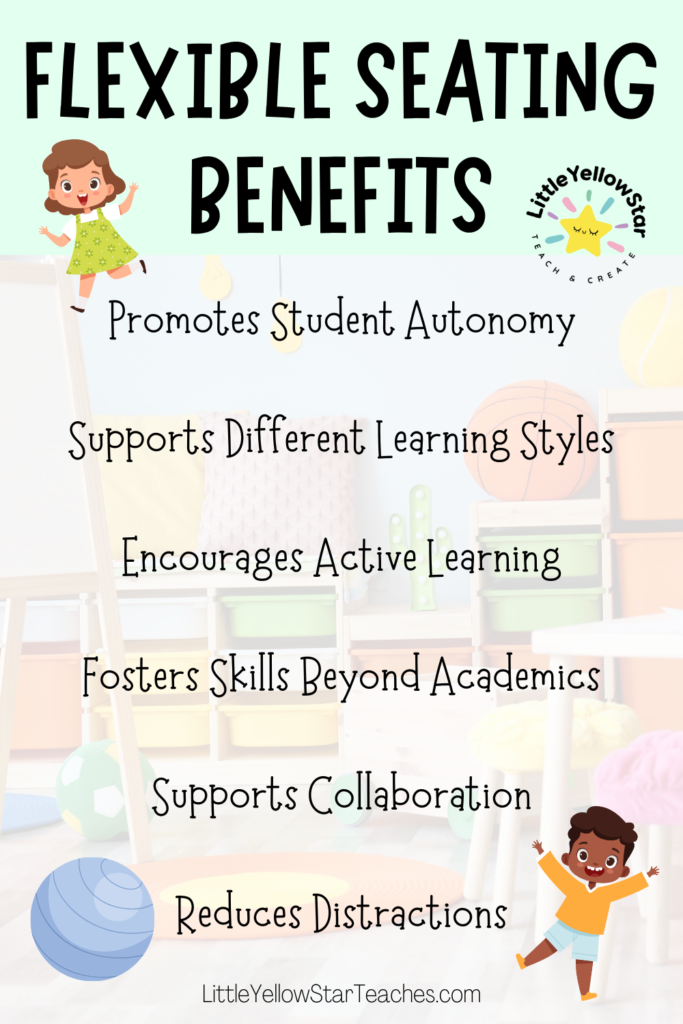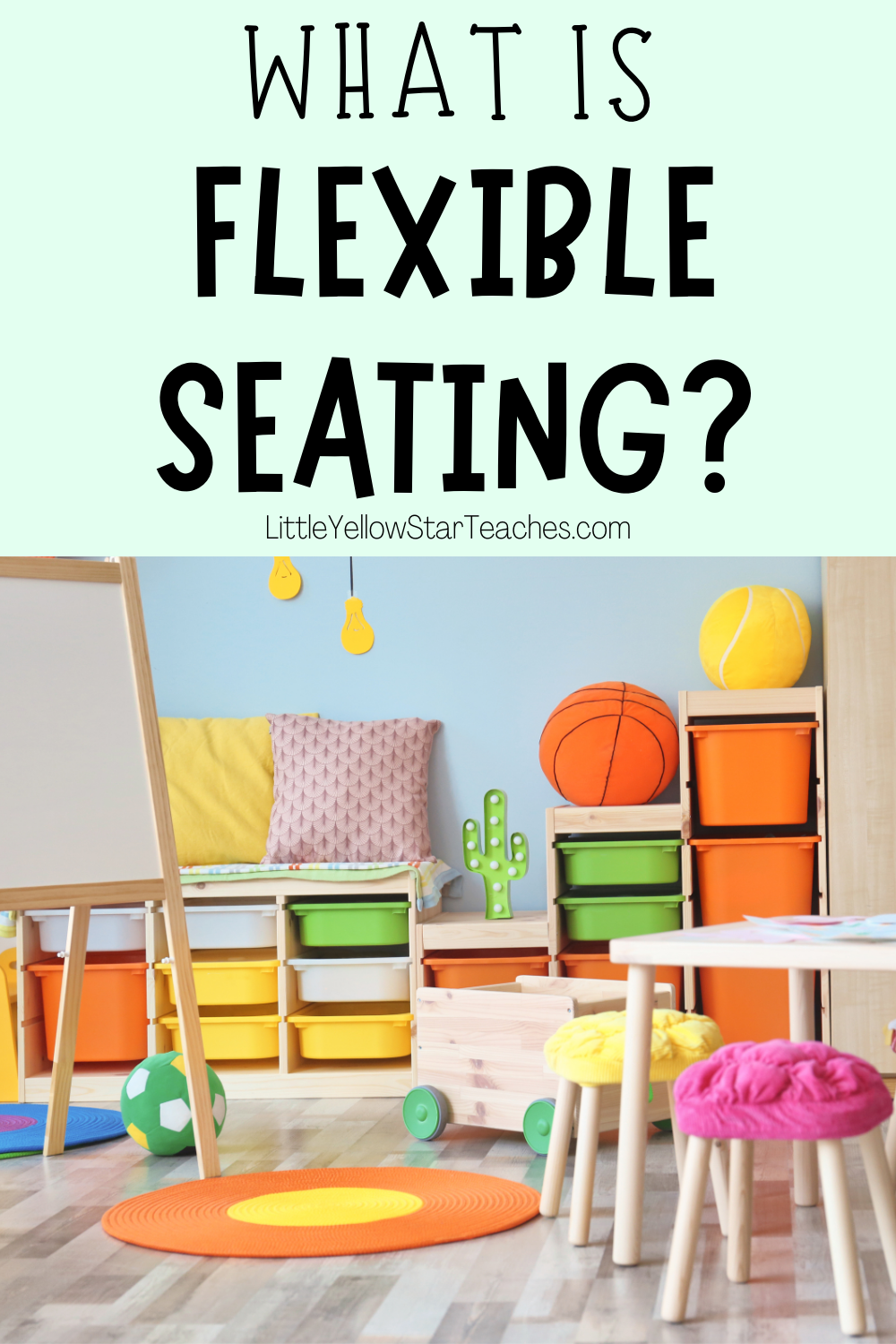“What is Flexible Seating?” you might ask. Imagine a classroom where desks are not your only option for sitting to listen and complete your work. Now, add more variety to this image: What if you could choose where and how you want to position your body? Sounds like a dream, doesn’t it?
So, what is flexible seating? It’s a simple yet powerful concept of having alternative seating for classrooms that can make learning more engaging and fun.
Are you under the impression that your classroom has to resemble a Pinterest-worthy masterpiece to reap the flexible seating benefits? Well, let me clarify: Just by introducing alternative seating options in your classroom, you open up a world of flexible seating benefits for your students.
Let me walk you through what it is, the benefits, and how you can implement it in your class. After this post, you might even be surprised to learn that you might have already been implementing some aspects of flexible seating in your classroom. Let’s get started.

What is Flexible Seating?
Flexible seating is a concept that gets rid of the traditional classroom setup (you know, those straight rows of desks we all sat in) and instead uses a variety of flexible seating options. It’s all about choice and comfort. The idea here is to let students choose where they work best.
What is flexible seating not? It’s not just a passing trend. Instead, it emerges from the understanding that every student learns differently, and our classroom environment should reflect that diversity. By offering flexible seating options, students are empowered to take control of their learning environment and make decisions that boost their engagement, comfort, and focus.
***Disclosure: This post contains an Amazon affiliate link that at no additional cost to you, I may earn a small commission when you purchase through the link from my blog. Thank you for your support!
The Importance of Flexible Seating in Modern Education
Before you decide to revolutionize your classroom, let’s take a look at the flexible seating benefits that entice teachers and schools worldwide to implement this approach.
Flexible Seating Benefits:
- Promotes Student Autonomy: This is probably the biggest benefit that I see when it comes to flexible seating. With the opportunity to choose their seating, students feel a sense of ownership in their learning environment. This can translate into increased engagement with the material and greater participation in class activities.
- Supports Different Learning Styles: Some students must move to learn, while others work best in quiet, comfortable corners. Flexible seating caters to all these different learning styles and needs, promoting inclusivity and a more personalized learning experience.
- Encourages Active Learning: Traditional desks can confine students to one spot for extended periods, which isn’t great for their physical health. Flexible seating options, such as standing desks or balance balls, allow for movement and contribute to better posture and overall physical health.
- Fosters Skills Beyond Academics: When students are given the power to choose their seating, they practice critical life skills like decision-making, problem-solving, and self-regulation. They also learn to respect and navigate the personal space of others, fostering empathy and cooperation.
- Supports Collaboration: Flexible seating encourages students to work together, fostering a more collaborative learning environment. This can boost teamwork skills, improve communication, and enable peer-to-peer learning.
- Reduces Distractions: With the freedom to choose where they sit, students can select spots where they are less likely to be distracted. This can improve focus and increase productivity.
Remember, the benefits of flexible seating will vary based on your classroom’s unique needs and dynamics. So, while it’s helpful to understand these potential benefits, it’s also essential to adapt and modify your flexible seating strategies to best support your students.
Now that we’ve covered the “WHY,” let’s tackle the “HOW.”

Implementing Flexible Seating in Your Classroom
How can you implement flexible seating in your classroom? The beauty of flexible seating is that there’s no one-size-fits-all. Your flexible classroom might look completely different from mine, and that’s okay.
You don’t need to overhaul your classroom or spend a fortune on new furniture! I started out with just pillows and allowing students to sit on the floor! It’s that simple. Here are four simple steps that I suggest you take when implementing flexible seating options in your classroom.
Grab these free resources to make your teaching life easier!
4 Steps To Implement Flexible Seating
- Know Your Students
- Every classroom is different. If you have the luxury of knowing your students and the dynamic before implementing flexible seating then you are way ahead of others in terms of making sure it is a success. If you know your students, you know how ready they are to have autonomy over picking their seating. Understanding that will help you come up with a clear implementation plan and set realistic expectations.
- Add Flexible Seating Options
- This is the fun part! What flexible seating is, is not changing your entire classroom furniture to meet a certain standard. But, to just add or switch seating options. For example, the FLOOR or under the desk is surprisingly a very popular option among students, and they are completely free!
- There are many flexible seating options out there. You can even DIY some, but here are some suggestions:
- Floor Pillows: Create a comfortable seat on the floor anywhere in your classroom.
- Bean bag chairs: Comfy and casual, great for reading corners.
- Bouncy balls: Engages the core and promotes focus. Students can just replace their chairs with a bouncy ball for the day.
- Wobble chairs: Allows movement while staying in place. This is so great if you can get the budget for it.
- Standing desks: Perfect for high-energy students or high-energy teachers! I replaced my own desk with a standing desk and would never go back!
- Couches: Need I say more? Make for a cozy, welcoming atmosphere. This totally changes the feel of your classroom.
- Set Clear Expectations
- This is the break it or make it part. As mentioned above, flexible seating empowers students to take ownership of their learning environment and make decisions that enhance their engagement, comfort, and focus. So any seating choice that does not fulfill that is not flexible seating.
- Like anything in the classroom, you need to set your expectations clearly. Create a T Chart to show What Flexible Seating Is and What It is Not. Discuss what are the consequences of not fulfilling the expectations.
- Reflect and Adjust
- Implementing flexible seating is an ongoing process. It’s NOT going to be perfect the first time, and if it is, please tag me on Instagram and let me know how you did it!
- If you feel like your students are not following the expectations, you can take it away. When implementing, even if you need to make some adjustments, you should experience some of the flexible seating benefits. So, if you are not and it is creating more stress, put it on pause, let your students earn it back, or try again next year! If it is not working for you, don’t keep going because other teachers are doing it.
So, Are You Going To Try Flexible Seating This School Year?

Flexible seating is more than just a fad or an aesthetic choice for your classroom. It responds to the understanding that every child learns differently and that our classroom environments should accommodate this diversity. More than that, it’s a simple, creative way to empower our students, making them active participants in their learning journey.
As teachers, our primary goal is to create an environment where our students can thrive. If flexible seating can assist in achieving that goal, then it is worth considering and experimenting with. Keep in mind that what works for one classroom may not work for another, and that’s okay. It’s all about finding what works best for you and your students.
In the end, remember this: whether it’s traditional desks and chairs, yoga balls, bean bags, or floor mats, what matters most is the learning and growth that happens in your classroom. So, don’t stress over making your classroom look like something out of Pinterest.
So, what is flexible seating truly about? It’s about offering choices and comfort that promote better learning, and that might just look like a couple of extra pillows on the floor and happy, engaged students.
Bye for now,
Prima from LittleYellowStar
* * *













